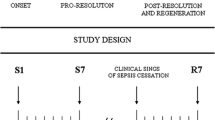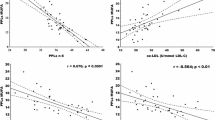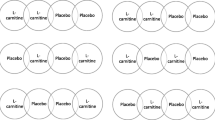Abstract
Paraoxonase 1 is believed to play a role in preventing lipid oxidation and, thus, limiting production of proinflammatory mediators. Systemic inflammatory response in sepsis increases oxidative stress and decreases high-density lipoprotein (HDL) concentrations. The objective of this study was to investigate serum paraoxonase 1 activities in critically ill patients with sepsis and after recovery. Serum paraoxonase 1 arylesterase/paraoxonase activities, concentration of total cholesterol, HDL cholesterol (HDL-C) and serum C-reactive protein (CRP) in septic patients of a medical intensive care unit (n = 30) and age/sex-matched outpatient controls without sepsis (n = 30) were analyzed. Paired convalescent samples were also taken 1 week after recovery (n = 11). In septic patients, both arylesterase (88.3 ± 36.5 vs. 162.1 ± 44.8 kU/l, P < 0.001) and paraoxonase (75.2 ± 50.0 vs. 125.2 ± 69.4 U/l, P < 0.01) paraoxonase 1 activities decreased as compared to controls. Both activities normalized after recovery. Negative correlation was found between CRP and both arylesterase (r = −0.676, P < 0.001) and paraoxonase (r = −0.401, P < 0.01) as well as positive correlation between HDL-C and both arylesterase (r = 0.585, P < 0.001) and paraoxonase (r = 0.405, P < 0.01) paraoxonase 1 activities. The decreased activity of paraoxonase 1 in negative correlation with CRP offers a potentially useful marker of sepsis progress and recovery in critically ill patients.

Similar content being viewed by others
References
Balk RA (2000) Severe sepsis and septic shock. Definitions, epidemiology, and clinical manifestations. Crit Care Clin 16:179–192
Martins PS, Kallas EG, Neto MC, Dalboni MA, Blecher S, Salomao R (2003) Upregulation of reactive oxygen species generation and phagocytosis, and increased apoptosis in human neutrophils during severe sepsis and septic shock. Shock 20:208–212
Alvarez C, Ramos A (1986) Lipids, lipoproteins, and apoproteins in serum during infection. Clin Chem 32:142–145
van Leeuwen HJ, Heezius EC, Dallinga GM, van Strijp JA, Verhoef J, van Kessel KP (2003) Lipoprotein metabolism in patients with severe sepsis. Crit Care Med 31:1359–1366
James RW, Deakin SP (2004) The importance of high-density lipoproteins for paraoxonase-1 secretion, stability, and activity. Free Radic Biol Med 37:1986–1994
Watson AD, Berliner JA, Hama SY, La Du BN, Faull KF, Fogelman AM, Navab M (1995) Protective effect of high density lipoprotein associated paraoxonase. Inhibition of the biological activity of minimally oxidized low density lipoprotein. J Clin Invest 96:2882–2891
Wu A, Hinds CJ, Thiemermann C (2004) High-density lipoproteins in sepsis and septic shock: metabolism, actions, and therapeutic applications. Shock 21:210–221
McElveen J, Mackness MI, Colley CM, Peard T, Warner S, Walker CH (1986) Distribution of paraoxon hydrolytic activity in the serum of patients after myocardial infarction. Clin Chem 32:671–673
Chait A, Han CY, Oram JF, Heinecke JW (2005) Thematic review series: the immune system and atherogenesis. Lipoprotein-associated inflammatory proteins: markers or mediators of cardiovascular disease? J Lipid Res 46:389–403
Mackness B, Hine D, McElduff P, Mackness M (2006) High C-reactive protein and low paraoxonase1 in diabetes as risk factors for coronary heart disease. Atherosclerosis 186:396–401
Dirican M, Akca R, Sarandol E, Dilek K (2004) Serum paraoxonase activity in uremic predialysis and hemodialysis patients. J Nephrol 17:813–818
Boehm D, Krzystek-Korpacka M, Neubauer K, Matusiewicz M, Berdowska I, Zielinski B, Paradowski L, Gamian A (2009) Paraoxonase-1 status in Crohn’s disease and ulcerative colitis. Inflamm Bowel Dis 15:93–99
Kumon Y, Nakauchi Y, Kidawara K, Fukushima M, Kobayashi S, Ikeda Y, Suehiro T, Hashimoto K, Sipe JD (1998) A longitudinal analysis of alteration in lecithin-cholesterol acyltransferase and paraoxonase activities following laparoscopic cholecystectomy relative to other parameters of HDL function and the acute phase response. Scand J Immunol 48:419–424
Parra S, Alonso-Villaverde C, Coll B, Ferre N, Marsillach J, Aragones G, Mackness M, Mackness B, Masana L, Joven J, Camps J (2007) Serum paraoxonase-1 activity and concentration are influenced by human immunodeficiency virus infection. Atherosclerosis 194:175–181
Aslan M, Nazligul Y, Horoz M, Bolukbas C, Bolukbas FF, Gur M, Celik H, Erel O (2008) Serum paraoxonase-1 activity in Helicobacter pylori infected subjects. Atherosclerosis 196:270–274
Feingold KR, Memon RA, Moser AH, Grunfeld C (1998) Paraoxonase activity in the serum and hepatic mRNA levels decrease during the acute phase response. Atherosclerosis 139:307–315
Bone RC, Balk RA, Cerra FB, Dellinger RP, Fein AM, Knaus WA, Schein RM, Sibbald WJ (1992) Definitions for sepsis and organ failure and guidelines for the use of innovative therapies in sepsis. The ACCP/SCCM Consensus Conference Committee. American College of Chest Physicians/Society of Critical Care Medicine. Chest 101:1644–1655
Knaus WA, Draper EA, Wagner DP, Zimmerman JE (1985) APACHE II: a severity of disease classification system. Crit Care Med 13:818–829
Eckerson HW, Wyte CM, La Du BN (1983) The human serum paraoxonase/arylesterase polymorphism. Am J Hum Genet 35:1126–1138
Van Lenten BJ, Hama SY, de Beer FC, Stafforini DM, McIntyre TM, Prescott SM, La Du BN, Fogelman AM, Navab M (1995) Anti-inflammatory HDL becomes pro-inflammatory during the acute phase response. Loss of protective effect of HDL against LDL oxidation in aortic wall cell cocultures. J Clin Invest 96:2758–2767
Gaidukov L, Tawfik DS (2005) High affinity, stability, and lactonase activity of serum paraoxonase PON1 anchored on HDL with ApoA-I. Biochemistry 44:11843–11854
Ganter U, Arcone R, Toniatti C, Morrone G, Ciliberto G (1989) Dual control of C-reactive protein gene expression by interleukin-1 and interleukin-6. EMBO J 8:3773–3779
Acknowledgments
This study was supported by a research grant from the Czech Ministry of Health (Project No. IGANR/8943-4).
Conflict of interest statement
The authors declare that they have no conflict of interest related to the publication of this manuscript.
Author information
Authors and Affiliations
Corresponding author
Rights and permissions
About this article
Cite this article
Novak, F., Vavrova, L., Kodydkova, J. et al. Decreased paraoxonase activity in critically ill patients with sepsis. Clin Exp Med 10, 21–25 (2010). https://doi.org/10.1007/s10238-009-0059-8
Received:
Accepted:
Published:
Issue Date:
DOI: https://doi.org/10.1007/s10238-009-0059-8




